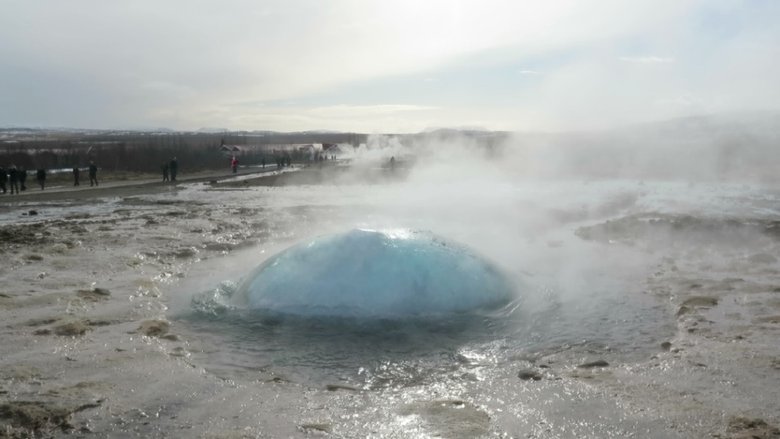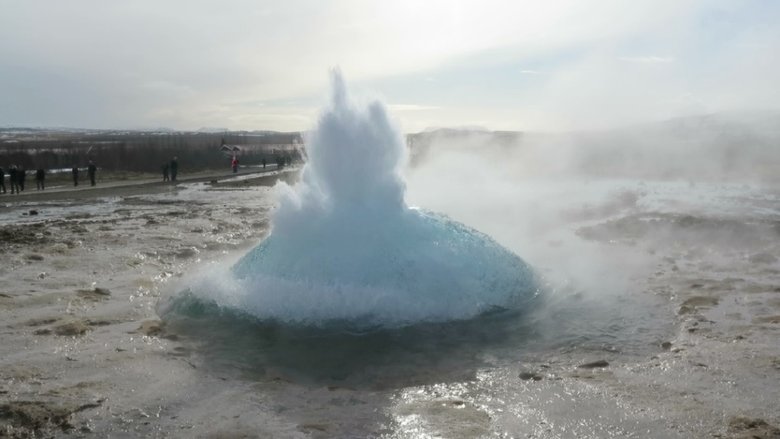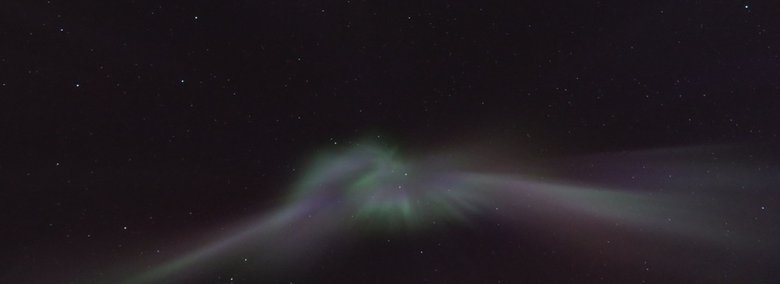Reykjavik and Golden Circle, March 16-18 and 31, 2015
We landed at Reykjavik early in the morning of March 16, but it was so windy the plane couldn't get to the gate for over an hour. It was still breezy when we finally got to the Betchart tour buses.
We had a short city tour after lunch, stopping at the Hallgrimskirkja church, built between 1945 and 1986.
The columns on the sides are designed to resemble the natural basalt columns we later saw at the southern tip of Iceland.
A statue of Leif Ericsson is in front of the church.
On March 17 we took the Golden Circle tour. First stop was Thingvellir on the western edge of a wide rift in the tectonic
plates. Here we're on the edge looking south to mountains and some geothermal steam plants.
The rift valley is about 30km wide here, with several rift features such as the Oxara river here. The church on the
other side was built in 1859 on the site of Iceland's first church in 1015.
This rift valley also includes Iceland's largest Lake Thingvallavatn and the Silfra rift where we later scuba dived.
Thingvellir is most noted for this location of Iceland's Althingi (assembly), which was Iceland's supreme
legislative and judicial authority from 930 until 1271.
The next Golden Circle stop was Gullfoss, probably Iceland's most famous waterfall, which is in 2 stages at right
angles.
A view down the gorge of the lower fall.
The final Golden Circle stop is Geysir. The namesake Great Geysir can be taller than Old Faithful but is currently
dormant. It is most active after earthquakes. The Strokkur geysir is more modest in size but erupts every 10 minutes or so. Its
unique feature is the translucent bubble that forms immediately before the eruption. Attempts to take still pictures were in
vain, so I shot video and extracted 2 clips.


We then stopped for a snack at the Friðheimar greenhouse, where tomatoes and cucumbers are grown with Iceland's
abundant geothermal heat.
As the tour was sponsored by the Planetary Society for the solar eclipse, aurora viewing was another priority. At 9PM we
boarded the buses to get away from Reykyavik's city lights. We had previously visited an aurora museum where we had
received photography instructions. Best results are with 8-10 seconds of exposure. I did not have a tripod, but there were
convenient waist-high street signs where I could brace the camera.
This picture was taken looking straight up.

Aurora is a phenomenon that usually looks better in pictures than live. The light is usually very pale to the eye, but
the colors come out with long exposures.
On March 18 we drove to the southwest Reykjanes peninsula. Once again the winds were up. Here's a bridge over a
tectonic plate rift.
At the edge of the peninsula is a statue of the Great Auk.
These flightless birds were actually about 3 feet tall and Iceland was their last habitat before their mid-19th century
extinction.
We then spent a couple of hours at the Blue Lagoon. Overview:
It was sleeting sideways most of the time we were there, so most people were near the edges on leeward sides of rock
outcroppings.
Liz with some facial mud.
Our favorite part was the hot water shower massage.
These tourist attractions within an hour or two of Reykjavik were surprisingly busy for the supposed off-season. We even
encountered a few British school groups. Betchart had reserved entry at the Blue Lagoon or we might have had a long wait to get
in.
We had one day in Reykjavik on own own at the end of the trip. Here's the 1990 Sun Voyager sculpture on the
waterfront.
We then visited the Viking museum near the airport. Liz is on the Islendingur, which is a replica ship that some
Icelanders sailed to Newfoundland in 2000 as a millennial celebration of Leif Ericsson's voyage.
After the 2010 volcano eruption that disrupted air travel, Icleand was worried that would scare off tourism and so began
aggressive promotion. This succeeded beyond expectations, with tourism rising from 300K in 2008 to over 1 million in 2014.
Icelandair offers free Reykjavik stopovers between Europe and North America. Consequently it pays to plan ahead for tourist
attractions near Reykjavik, which also has 80% of Iceland's 400,000 people. The rest of the country is much quieter and
quite pristine.